This article also appears in Global Nerdy.
It’s a busy, meeting-filled day for Yours Truly down at the local headquarters for The Empire. Here’s a (slightly edited) photo that I took at our big Evangelism team meeting around 3:30 this afternoon:

This article also appears in Global Nerdy.
It’s a busy, meeting-filled day for Yours Truly down at the local headquarters for The Empire. Here’s a (slightly edited) photo that I took at our big Evangelism team meeting around 3:30 this afternoon:

If you’re a developer or IT Pro based in Canada, my team at Microsoft Canada – the Technical Audience Team – would like to pick your brain in order to find out how to better serve you. The full details are in my tech blog, Global Nerdy.
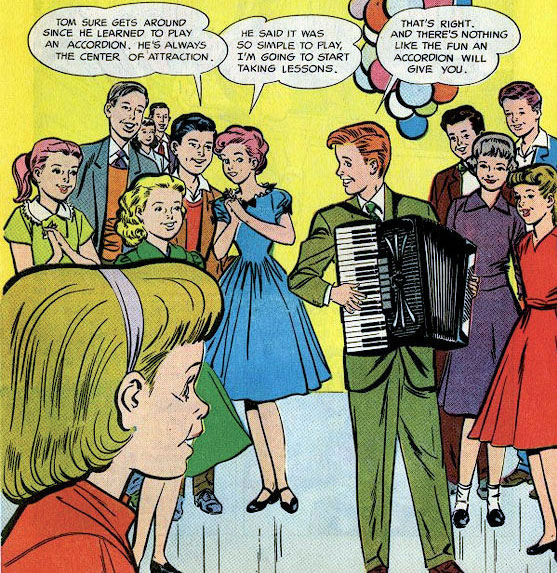
Back in 1989, Tom Torriglia – formerly of the band Those Darn Accordions and now a member of Bella Ciao – established the month of June as Accordion Awareness Month, making this June the 20th anniversary. The purpose of Accordion Awareness Month is to let the world know that the accordion’s making a comeback and invite people to understand the true musical (and in my case, life-changing) potential of my favourite instrument. In honour of this very special month, I’ll be posting stories about accordion as well as other accordion-related news, as well as doing some performances all over town (the Roller Derby was just the beginning).
I’m not the only one doing something special for Accordion Awareness Month. The fine folks at the all-things-accordion blog Let’s Polka are challenging accordion players and enthusiasts to take the Accordion Awareness Month pledge. They’re asking you to do something to promote The Instrument of the Gods:
This year, we want you — our humble, accordion-loving readers — to help promote the virtues of our favorite instrument. Sit on your porch and play some tunes for your neighbors, attend a show on our accordion event calendar, fill up your coworker’s iPod with Flaco Jimenez songs when he isn’t looking, tell all your friends about Let’s Polka… the possibilities are limitless. Me, I’m going to sit on my balcony every night, directly above a pizzeria, and serenade patrons.
To encourage you, we’re giving away over $100 worth of accordion-related goodies to readers who pledge to promote the accordion this month. To make your pledge, write a comment on this post and tell us how you plan to celebrate Accordion Awareness Month — doesn’t matter if it’s something small (making a YouTube video) or big (writing an accordion concerto). One lucky, randomly-chosen pledger will receive a prize package packed with accordion CDs, books, and more. (Prize details coming soon!)
Happy Accordion Awareness Month! Let the squeezing begin!
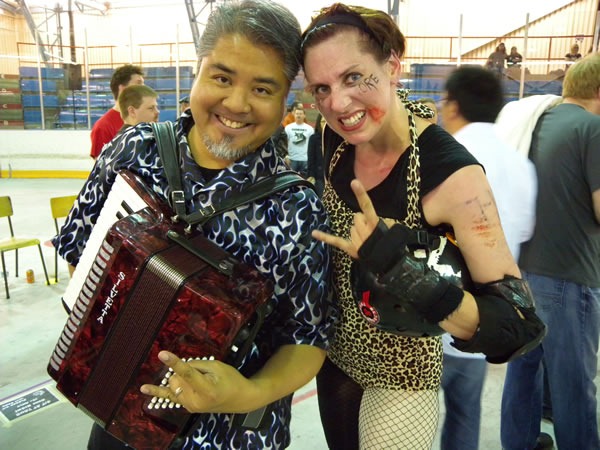 Me and "Lunchbox” of the Gore Gore Rollergirls. Photo by Rannie “Photojunkie” Turingan.
Me and "Lunchbox” of the Gore Gore Rollergirls. Photo by Rannie “Photojunkie” Turingan.
I’d only seen roller derby on TV – hidden deep in UHF-land — and never in real life, so when I got an invitation from “Lunchbox” of the Gore Gore Rollergirls to play the national anthem at the start of the first roller derby match of the season, I jumped at the opportunity.
The Ginger Ninja and I showed up early at George Bell Arena so that I could meet the organizers and get an advance look at the setup. We had a look around the arena and hung out in the beer room for a while. While there, I played some Nine Inch Nails at a friend’s request, which was a good warm-up for my performance.
Game time rolled around, and after Crankypants, Toronto Roller Derby’s master of ceremonies introduced the teams – the Gore Gore Rollergirls and Chicks Ahoy! – he introduced me to the audience as “Joey deVilla, the Accordion Guy”, and led to me to the dual-microphone setup.
 Me playing the national anthem, as seen from the stands. Photo by Rannie “Photojunkie” Turingan.
Me playing the national anthem, as seen from the stands. Photo by Rannie “Photojunkie” Turingan.
I decided that since we were in a hockey arena, it was only fitting that I played both the unofficial and official national anthems. I started the original Hockey Night in Canada theme, which I thought would please the crowd. I was right – they cheered so loud that they drowned out the final notes. I followed up with O Canada and was joined by the players and referees, who sang with great pride and gusto. I closed with the classic hockey fight chords, took my bows and then joined the audience to catch the match.
Here’s the video of my performance:
You can watch the game from the stands, which a lot of people did…
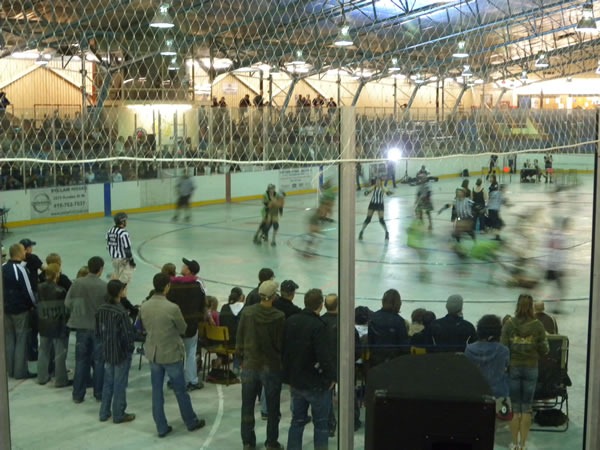
…but if you really want a nice close-up look at the action, there’s an area right on the rink called the “Suicide Seats”. I highly recommend it:
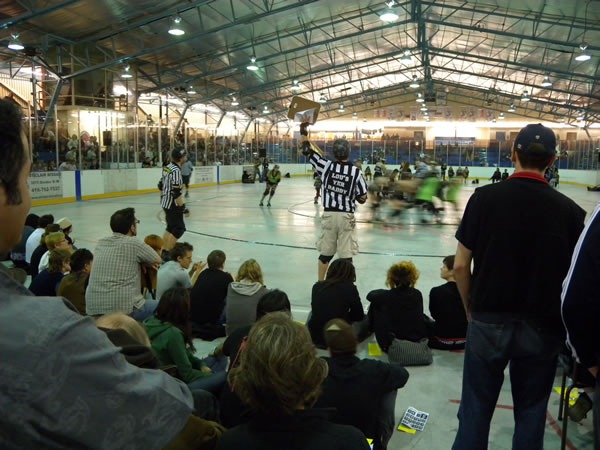
I knew that roller derby players took on a nom de guerre, and but I didn’t know that they could also take on oddball numbers, such as 7-11, the Roman numeral XVIII, or <3. One player even had the mathematical expression e raised to the power of pi times i, which is the left side of Euler’s formula.
Not only do the players take on names; the refs do too! Here’s one of them, “The Big Leboutski”:

Here’s another one, going by the name of “Lou’s Yer Daddy”:
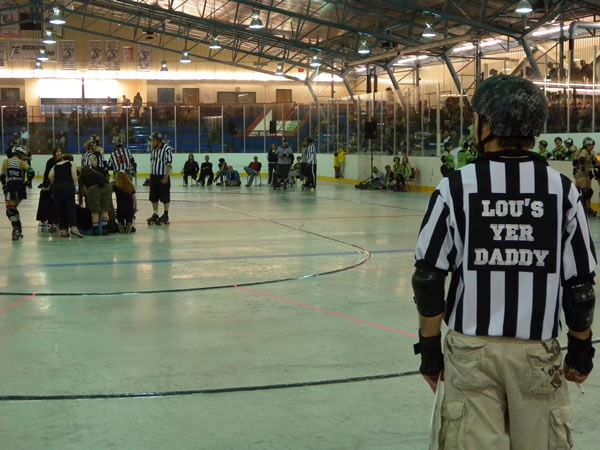
All local hockey arenas have a sort of time-warp feeling to them. The architecture, signage and seats always make you feel as though you’ve stepped back into the late 1950s. I kept half-expecting to see the Hanson brothers waiting for some ice time. The crowd was a friendly, interesting mix; it was as if the families and friends of Junior A hockey and Queen West tattoo shop customers teamed up to throw a party. The overall vibe is an odd combination of small-town charm and big city “alternative”. It occurred to me that roller derby would make a great setting for a film, but a little searching revealed that Drew Barrymore had the same idea and ran with it.
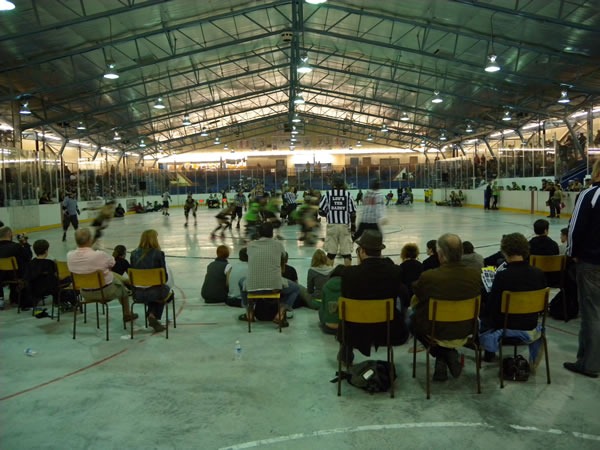
Here’s a Gem City Rollergirls video that explains the rules of roller derby:
And now, some photos from the bout:
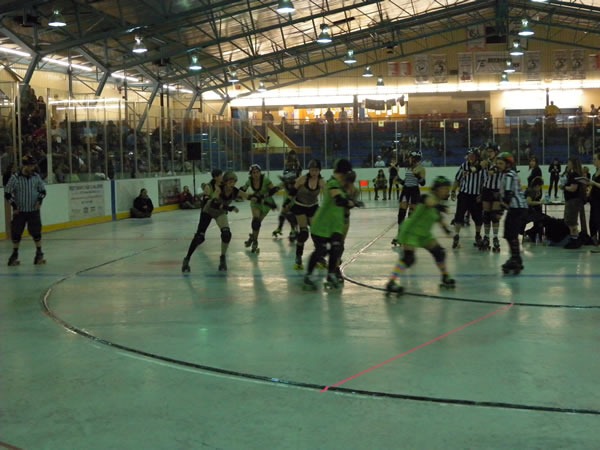
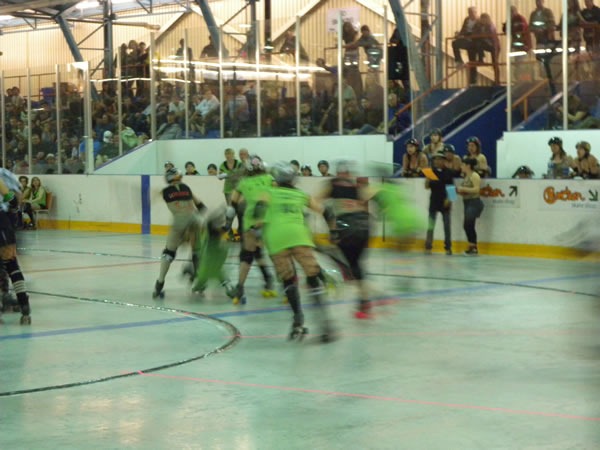


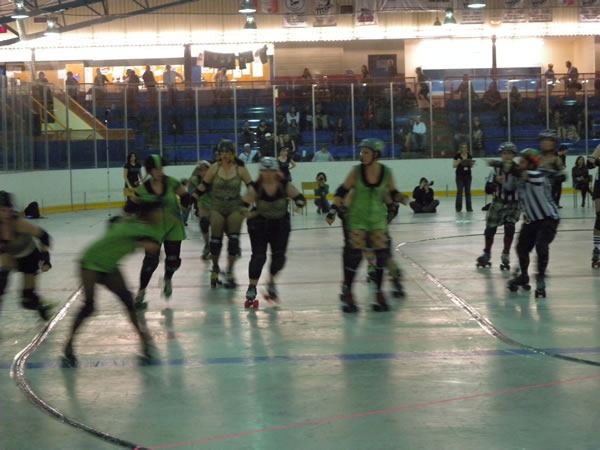
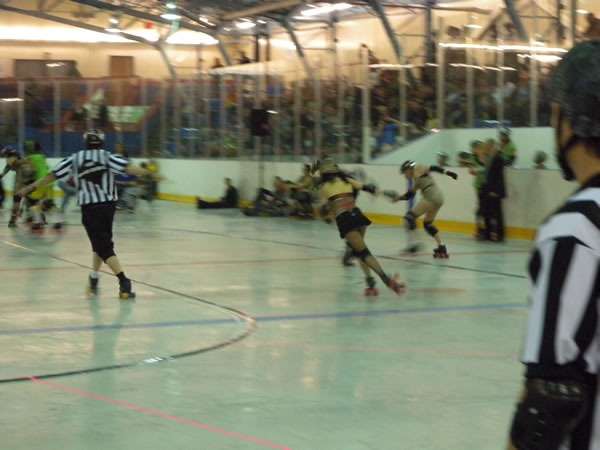
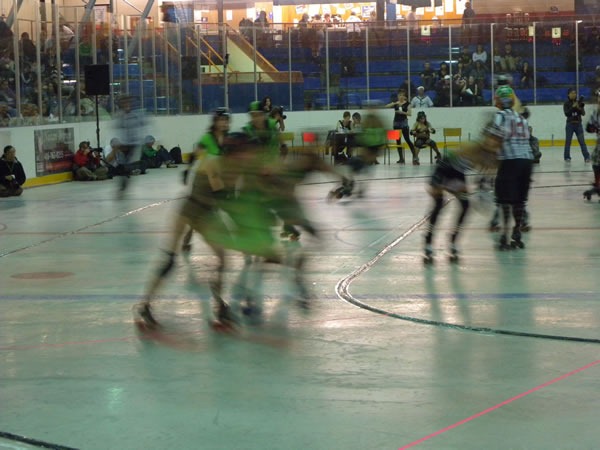

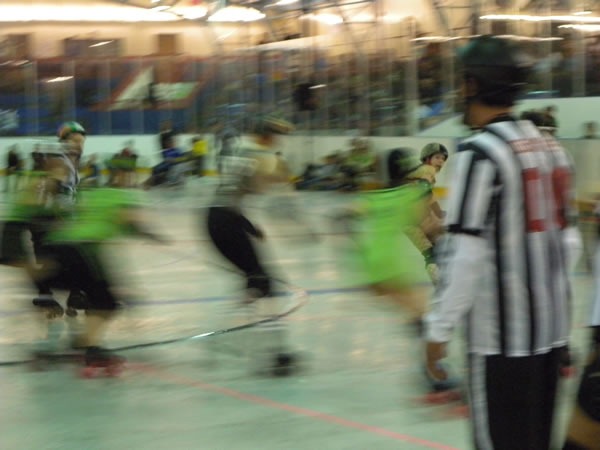


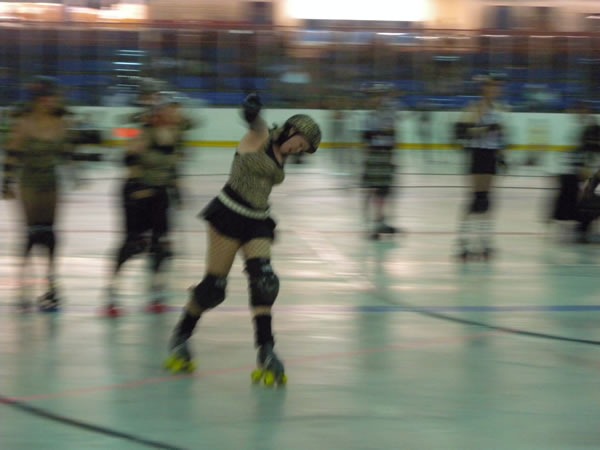
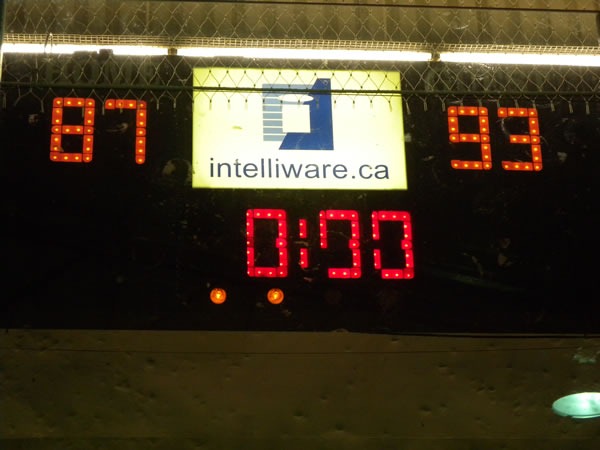
Although Chicks Ahoy managed to get an early lead in the bout, the Gore Gore Rollergirls rallied and won with a score of 93-87.
We managed to catch up with Lunchbox after the bout..

…where she was only too happy to chat with the fans, pose for pictures and sign autographs.

All in all, a great evening. I’d gladly play the anthem and see a bout again!
Tomorrow at the George Bell Arena in Accordion City’s west end, I’ll be playing (and singing) Canada’s National Anthem at the start of the Toronto Roller Derby match between the Gore-Gore Rollergirls and Chicks Ahoy! I’m working on a rendition that respects the proud heritages of both Canada and roller derby.
If you’d like to hear my rockin’ accordion rendition of O Canada and enjoy some roller derby (the motto is “Real Women. Real Hits. Real Heart.”), it’s all happening at the George Bell Arena (215 Ryding Avenue, in the “Junction” neighbourhood). Tickets are $12 in advance, $15 at the door and kids under 7 get in free. The doors open at 6:30 p.m. and the game starts at 7:30, which is when I figure I’ll be playing.
For those of you who can’t remember or don’t know the words to our anthem, here they are:
O Canada!
Our home and native land!
True patriot love
In all thy sons command.With glowing hearts
We see thee rise,
The True North strong and free!
From far and wide,
O Canada,
We stand on guard for thee.God keep our land
Glorious and free!
O Canada, we stand on guard for thee.
O Canada, we stand on guard for thee.
I’ll post my chord arrangements later.
And, as further enticement, here are the Gore-Gore Rollergirls:
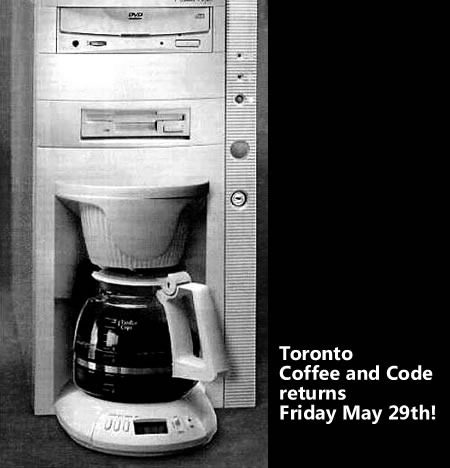
Yes, Toronto Coffee and Code returns today! It’s a day when I make myself (and by extension, Microsoft) very accessible by working out of a cafe and answering your questions, getting your opinions and sharing ideas. Once again, it’ll take place at the Dark Horse Cafe at 215 Spadina, near the lights between Dundas and Queen.
I’ve got some stuff to do at Microsoft Canada HQ in the morning, so I’m declaring tomorrow’s schedule to run from 1:00 p.m. to 6:00 p.m.. I might be there earlier, but I thought I’d give myself extra time in case traffic decides not cooperate. I’ll see you there!
Yup, another article originally published in my tech blog, Global Nerdy. As with the previous two, this one is of interest not just to programmers, but anyone using portable and mobile computing devices, such as smartphones, netbooks and laptops.
If you’re pressed for time, the graphic below – which takes its inspiration from these articles by Kathy “Creating Passionate Users” Sierra — captures the spirit of this article rather nicely:
If you have a little more time to spare, I’m going to explain my belief that while netbooks have a nifty form factor, they’re not where the mobile computing action is.
When I was Crazy Go Nuts University’s second most notorious perma-student (back in the late ‘80s/early ‘90s), I took a handful of business courses at the recommendation of my engineering and computer science professors. “You’re going to have to learn to speak the suits’ language,” they said. Crazy Go Nuts University has a renowned business school and I thought it would be a waste not to take at least a couple of business courses. I especially liked the Marketing couse, and one lecture stands out in my mind: a case study comparing the dessert offerings of two major fast food chains.
In the interest of not attracting the attention of their lawyers, I’m going to refer to the chains as:
Both Monarch Burger and Jester Burger offered a dessert that went by the name “apple pie”. Let’s examine them.
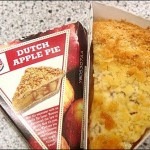 Monarch Burger went to the trouble of making their apple pie look like a slice of homemade apple pie. While it seems appealing in its photo on the menu, it sets up a false expectation. It may look like a slice of homemade apple pie, but it certainly doesn’t taste like one. Naturally, it flopped. Fast-food restaurants are set up to be run not by trained chefs, but by a low-wage, low-skill, disinterested staff. As a result, their food preparation procedures are designed to run on little thinking and no passion. They’re not set up to create delicious homemade apple pies.
Monarch Burger went to the trouble of making their apple pie look like a slice of homemade apple pie. While it seems appealing in its photo on the menu, it sets up a false expectation. It may look like a slice of homemade apple pie, but it certainly doesn’t taste like one. Naturally, it flopped. Fast-food restaurants are set up to be run not by trained chefs, but by a low-wage, low-skill, disinterested staff. As a result, their food preparation procedures are designed to run on little thinking and no passion. They’re not set up to create delicious homemade apple pies.
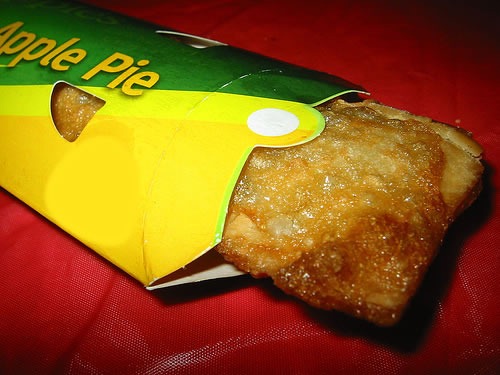
Jester Burger’s approach was quite different. Their dessert is called “apple pie”, but it’s one in the loosest sense. It’s apple pie filling inside a pastry shell shaped like the photon torpedo casings from Star Trek. In the 70s and 80s, the pastry shell had bubbles all over it because it wasn’t baked, but deep-fried. After all, their kitchens already had deep fryers aplenty – why not use them?
Unlike Monarch Burger’s offering, Jester Burger’s sold well because it gave their customers a dessert reminiscent of an apple pie without setting up any expectations for real apple pie.
Jester Burger’s pie had an added bonus: unlike Monarch Burger’s pie, which was best eaten with a fork, Jester Burger’s pie was meant to be held in your hand, just like their burgers and fries.
At this point, I am obliged to remind you that this isn’t an article about 1980s-era desserts at fast food burger chains. It’s about netbooks and smartphones, but keep those pies in mind…
Netbooks remind me of Monarch Burger’s apple pie. Just as Monarch Burger tried to take the standard apple pie form and attempt to fit it into a fast food menu, the netbook approach tries to take the standard laptop form and attempt to fit it into mobile computing. The end result, to my mind, is a device that occupies an uncomfortable, middle ground between laptops and smartphones that tries to please everyone and pleases no one. Consider the factors:
To summarize: Slightly bigger and pricier than a phone, but can’t phone. Slightly smaller and cheaper than a laptop, but not that much smaller or cheaper. To adapt a phrase I used in an article I wrote yesterday, netbooks are like laptops, but lamer.
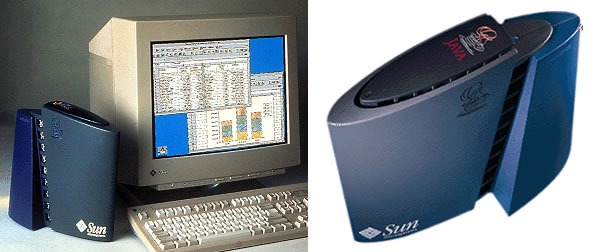
The uncomfortable middle ground occupied by the netbook reminds me of another much-hyped device that flopped – the network computer, which also went by the name "thin client". In the late 90s, a number of people suggested that desktop computers, whose prices started at the mid-$1000 range in those days, would be replaced by inexpensive diskless workstations. These machines would essentially be the Java-era version of what used to be called "smart terminals", combining local processing power with network-accessed storage of programs and data.
A lot of the ideas behind the network computer ended up in today’s machines, even if the network computer itself didn’t. Part of the problem was the state of networking when the NC was introduced; back then, broadband internet access was generally the exception rather than the rule. Another major factor was price – desktop and even laptop computers prices fell to points even lower than those envisioned for NCs. Finally, there was the environment in which the applications would run. Everyone who was betting on the NC envisioned people running Java apps pushed across the network, but it turned out that the things they had dismissed as toys — the browser and JavaScript, combining to form the juggernaut known as Ajax — ended up being where applications "lived".
When I look at netbooks, I get network computer deja vu. I see a transitory category of technology that will eventually be eclipsed. I think that laptops will eventually do to netbooks what desktop machines did to network computers: evolve to fill their niche. Just as there are small-footprint desktop computers that offer all the functionality and price point of a network computer along with the benefits of local storage, I suspect that what we consider to be a netbook today will be just another category of laptop computer tomorrow.
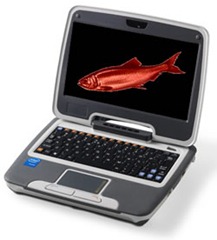
I’m going to go a little farther, beyond stating that netbooks are merely the present-day version of the network computer. I’m going to go beyond saying that while their form factor is a little more convenient than that of a laptop, the attention they’re getting – there’s a lot of hoo-hah about who’s winning in the netbook space, Windows or Linux – is out of proportion to their eventual negligible impact. I’m going to go out on a limb and declare them to be a dangerous red herring, a diversion from where the real mobile action is.
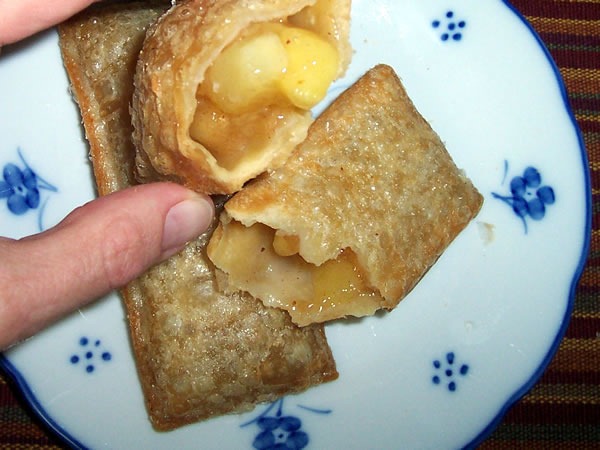
A quick aside: The photo above is not of a Jester Burger fried apple pie. In response to their customers’ so-called health concerns (really, if those concerns were real, they’d stop eating there), they started phasing out the fried pies in 1992 in favour of the baked kind. There are still some branches of Jester Burger that carry the fried pies, but a more reliable source is a fast food chain that I’ll refer to as “Southern Chicken Place”, or SCP for short. Those pies in the photo above? They’re from SCP.
Jester Burger made no attempt to faithfully replicate a homemade apple pie when they made their dessert. Instead, they engineered something that was “just pie enough” and also matched the environment in which it would be prepared (a fast food kitchen, which didn’t have ovens but had deep fryers) and the environment in which it would be eaten (at a fast food restaurant table or in a car, where there isn’t any cutlery and everything is eaten with your hands). The Jester Burger pie fills a need without pretending to be something it’s not, and I think smartphones do the same thing.
Smartphones are truly portable. They really fit into your pocket or hang nicely off your belt, unlike netbooks:
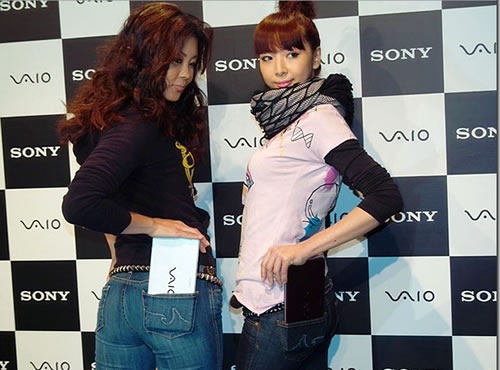
And smartphones are meant to be used while you’re holding them:
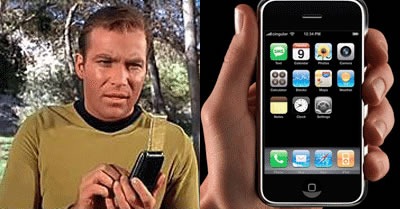
Just try that with a netbook. In order to really use one, you’ve got to set it down on a flat surface:

The best smartphones make no attempt to faithfully replicate the laptop computer experience in a smaller form. Instead, they’re “just computer enough” to be useful, yet better fit the on-the-go situations in which they will be used. They also incorporate mobile phones and MP3s – useful, popular and familiar devices — and the best smartphones borrow tricks from their user interfaces.
Smartphones, not netbooks, are where the real advances in mobile computing will be made.
One again, the thesis of this article, in graphic form:
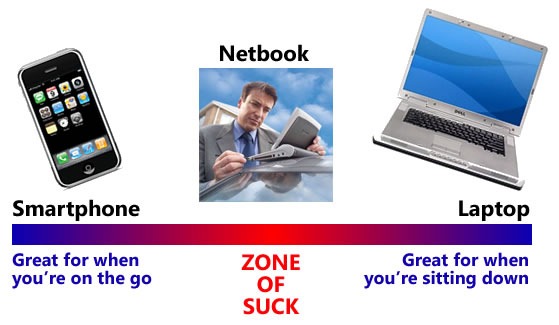
In the late 80s and early 90s, the people chose the fast food apple pie they wanted: the convenient, if not exactly apple pie-ish Jester Burger pie over Monarch Burger’s more-like-the-real-thing version.
When people buy a smartphone, which they’ve been doing like mad, they’re buying their primary mobile phone. It’s the mobile phone and computing platform that they’re using day in and day out and the device that they’re pulling out of their pockets, often to the point of interrupting conversations and crashing the trolley they’re operating.
When people buy a netbook, they’re often not buying their primary machine. It’s a second computer, a backup device that people take when their real machine – which is often a laptop computer that isn’t much larger or more expensive – seems like too much to carry. It’s a luxury that people might ditch if the current economic situation continues or worsens and as the differences between laptops and netbooks vanish. Netbooks, as a blend of the worst of both mobile and laptop worlds, will be a transitional technology; at best, they’ll enjoy a brief heyday similar to that of the fax machine.
The people are going with smartphones, and as developers, you should be following them.